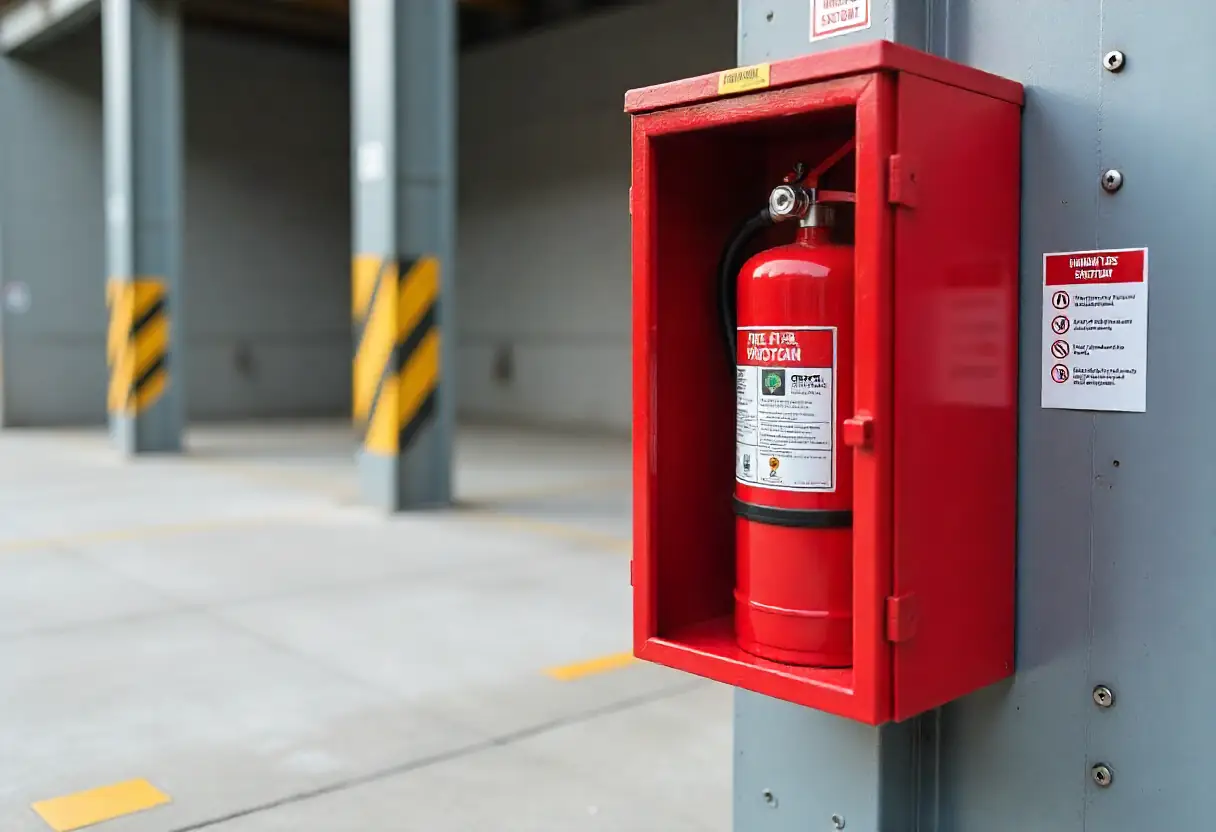How to Create an Emergency Evacuation Plan: A Construction Site Safety Guide

Did you know the Atlantic Basin faced 26 named storms in 2020 - more than double the usual 12? With nine hurricanes and three major storms, the need for emergency preparedness has never been clearer. Construction sites are high-risk environments, vulnerable to natural disasters like hurricanes, tornadoes, and earthquakes, as well as workplace emergencies such as fires, explosions, and chemical spills. According to OSHA, an Emergency Action Plan (EAP) is critical for organizing employer and employee actions during emergencies.
A well-crafted construction site evacuation plan reduces risk, protects workers, minimizes property damage, and ensures compliance with OSHA safety regulations. By identifying hazards and implementing tailored response procedures, job site evacuation protocols can significantly reduce injury and disruption. In this comprehensive guide, you'll learn how to create a construction site emergency evacuation plan that keeps your team safe and your project on track.
Why Emergency Evacuation Plans Matter in Construction
Construction sites present unique emergency challenges that demand careful planning. A disorganized evacuation can lead to confusion, injury, and property damage. Understanding why emergency evacuation plans matter could make the difference between life and death for construction workers and project managers alike.
Legal requirements and OSHA standards
OSHA regulations explicitly require written Emergency Action Plans (EAPs) for construction sites. Under 29 CFR 1910.38 and 1926.35, employers must develop and maintain a written emergency response plan that's readily available to all employees. For smaller operations with 10 or fewer employees, the plan may be communicated orally instead of in writing.
The regulations mandate that your EAP must include, at minimum:
- Procedures for reporting emergencies
- Evacuation routes and emergency exits
- Procedures for employees who remain to perform critical operations
- Methods to account for all employees after evacuation
- Rescue and medical duties for designated employees
- Names or job titles of persons to contact for additional information

Impact on worker safety and project timelines
Well-developed emergency response plans with proper employee safety training result in fewer and less severe injuries along with reduced structural damage. Conversely, a poorly prepared plan likely leads to disorganized response, causing confusion and injuries that affect your entire construction project.
Emergency situations can disrupt or completely shut down construction activities, causing significant schedule delays. Furthermore, these incidents may damage existing property and create financial burdens that extend well beyond the immediate crisis, affecting business continuity.
Benefits of proactive emergency planning
Proactive emergency planning offers numerous advantages for construction companies. First, it helps meet legal compliance requirements while avoiding potential OSHA fines. Additionally, it prioritizes worker safety by minimizing risks and creating accountability.
Perhaps most importantly, proactive planning ensures operational continuity and supports disaster recovery efforts. Even incidents where no worker is harmed can disrupt operations, potentially causing budget overruns and unplanned downtime. A comprehensive evacuation plan allows your team to respond efficiently to emergencies, minimizing these disruptions and supporting overall crisis management.
At Recovery Pros, we help construction teams recover quickly after emergencies - fires, floods, structural damage, or chemical spills. If your site needs a fast, expert-led recovery plan after a critical event, contact us for a free consultation.
Key Components of a Construction Site Evacuation Plan
Creating an effective construction site emergency evacuation plan requires several essential components working in harmony. The right elements ensure everyone on site can respond appropriately to emergencies, regardless of their nature or severity.

Emergency contact lists and site maps
Every construction site evacuation plan must begin with comprehensive emergency contact information. Your emergency response numbers should include:
- Site superintendent's phone number
- Alternative site contact information
- Local emergency services (police, fire department, poison control)
- Nearest hospital location and contact details
- Utility companies (electric, gas, water)
- Complete site address with directions
Site maps complement contact information by visually representing the entire construction area. These maps should display buildings, surrounding areas, major exits, evacuation routes, and muster points. Ideally, store copies of these maps in emergency response kits accessible to first responders.
Evacuation route signage and exits
Proper signage represents a critical element of any evacuation plan. All exit routes must be clearly marked, well-lit, and wide enough to accommodate evacuating personnel. Moreover, evacuation routes should avoid potentially hazardous areas or operations.
When developing evacuation maps, designate at least one primary and one secondary exit positioned to minimize the possibility that both might be blocked simultaneously by a single emergency. Exit signs must be strategically placed in locations where the direction to reach the nearest emergency exit isn't immediately apparent.

Shelter-in-place vs. full evacuation
Not all emergencies require evacuation. In cases involving extreme weather, dangerous chemicals, or certain other hazards, sheltering in place might be safer. Your plan should clearly specify conditions that require evacuation versus those that call for shelter in place procedures.
For shelter-in-place scenarios, designate interior rooms without windows where employees can gather safely. These areas should contain essential emergency supplies including non-perishable food, water, radios, and first aid equipment.
Fire evacuation construction protocols
Fire emergencies require specialized protocols. Your plan should detail specific procedures for reporting fires, activating alarms, and determining when staff should attempt to use fire extinguishers to fight small fires versus evacuating immediately.
Designate assembly areas outside the building where workers can gather following evacuation. These muster points should be a safe distance from the building and allow for accounting of all personnel.

Medical response and first aid roles
Construction site medics play a vital role in emergency response. These trained professionals can provide immediate assistance for medical emergencies ranging from minor cuts to cardiac events. Your plan should identify personnel responsible for first aid administration and detail procedures for accessing emergency medical equipment.
On larger sites, consider designating evacuation wardens (approximately one per 20 employees) responsible for checking work areas, ensuring all personnel evacuate, and accounting for everyone at assembly points. These wardens should also be trained in CPR and basic first aid.
Whether your team is recovering from a fire, flood, or safety incident - or you simply want a rapid-response partner ready when disaster strikes - Recovery Pros is here to help. We specialize in fast cleanup, damage assessment, and restoration tailored to construction sites. Book a free consultation.
Training, Communication, and Team Coordination
The effectiveness of any construction site emergency evacuation plan hinges on proper training, clear communication, and coordinated teamwork. Ensuring all team members understand their roles can mean the difference between chaos and order during an emergency.
Site supervisor responsibilities during emergencies
Site supervisors serve as first responders during emergencies, bearing significant responsibility for worker safety. They must assess situations, supervise evacuation efforts, coordinate with external emergency services, and direct operations shutdown when necessary. Essentially, supervisors must take immediate steps to correct unsafe conditions within their authority and follow up to ensure timely completion of corrective measures.
How to communicate during a crisis
Two-way radios prove far more effective than cellphones during emergencies, offering immediate communication with features like "Man Down" and emergency alert buttons. For contained job sites, PA systems allow for mass announcements. Hence, clear communication protocols should include:
- Distinctive alarms with visual and audible components
- Predetermined informers who can deliver news calmly
- Buddy systems for high-risk tasks
Training new hires and subcontractors
Training should occur when plans are initially developed, when new employees are hired, and when new equipment or processes are introduced. Notably, all contractors and suppliers must complete required safety training before starting work, with annual refreshers. Consider partnering with organizations like the American Red Cross for comprehensive CPR training and other emergency response skills.
Posting and distributing the emergency plan
Emergency response plans must be written, readily accessible, and prominently displayed with evacuation maps and assembly points clearly marked. Prior to implementation, review plans with all employees and ensure they understand the evacuation procedure.
Emergencies don’t wait - and neither should your response. Recovery Pros supports construction teams before, during, and after critical incidents with expert cleanup, safety assessments, and fast damage remediation. Contact us to get recovery-ready.
Testing and Updating Your Emergency Action Plan
An emergency action plan is never truly complete - regular testing and updates are vital to its continued effectiveness. Indeed, without practice, even the most comprehensive plan may fail when needed most.
How to run realistic evacuation drills
Effective drills come in three forms: walkthrough drills for slow practice, scheduled drills for methodical training, and unannounced drills to test real-world readiness. For maximum benefit, conduct evacuation drills at least twice a year and include outside resources like fire and police departments whenever possible. These drills should also cover scenarios such as heavy equipment failures and fall arrest rescues.

Evaluating plan effectiveness
After each drill, gather management and employees to assess what worked and what didn't. Document response times, adherence to assigned roles, and communication effectiveness. This systematic evaluation helps identify bottlenecks and safety gaps throughout your emergency procedures.
Incorporating feedback from drills
Create a structured after-action report detailing performance against goals. Subsequently, implement approved changes based on lessons learned - this continuous improvement process ensures your plan evolves with each practice session, enhancing overall emergency management strategies.
Keeping your plan current with site changes
Review your emergency response plan every six months and update whenever:
- Employee roles or responsibilities change
- Facility layout or design is modified
- New equipment or hazardous materials are introduced
- Site conditions or personnel change
When seconds matter, you need a team that moves fast. Recovery Pros helps your job site recover from emergencies with minimal delays - from site cleanup and structural drying to full restoration. Get in touch for a site-specific emergency recovery consultation.
Conclusion
Emergency evacuation plans are a vital part of construction site safety, helping protect workers, meet OSHA requirements, and prevent costly disruptions. Throughout this guide, you’ve explored the importance of having a well-structured emergency action plan (EAP), key elements like clear evacuation routes, designated assembly points, and role assignments, as well as how to train employees and conduct effective evacuation drills.
Every construction site faces unique hazards - from fires and explosions to severe weather and hazardous materials - making a customized emergency response plan essential. OSHA compliance is just the start; your true goal is safeguarding lives and keeping your project on schedule. Review and update your plan regularly, especially when site conditions change or new risks are identified.
Schedule evacuation drills at least twice a year and revise your protocols based on performance and feedback. Investing in a strong construction site emergency evacuation plan proves your commitment to safety, preparedness, and professional responsibility.
Be ready before disaster strikes - and know who to call when it does. Recovery Pros is your go-to partner for fire, flood, and emergency damage recovery on NYC construction sites. We respond fast, work with your project teams, and help you get back on track. Contact us for a free consultation.
Key Takeaways
Creating an effective emergency evacuation plan is essential for construction site safety, legal compliance, and operational continuity. Here are the critical insights every construction manager should implement:
• OSHA requires written Emergency Action Plans for construction sites - Include evacuation routes, emergency contacts, employee accounting procedures, and rescue duties to meet legal compliance standards.
• Designate primary and secondary evacuation routes with clear signage - Ensure exits are well-lit, wide enough for personnel, and positioned so both routes won't be blocked simultaneously.
• Train all workers including subcontractors on emergency procedures - Conduct training during onboarding, when introducing new processes, and provide annual refreshers with hands-on practice.
• Test your plan with realistic drills at least twice yearly - Run walkthrough, scheduled, and unannounced drills to identify weaknesses and improve response times.
• Update your emergency plan every six months or when site conditions change - Review and revise whenever facility layout changes, new equipment arrives, or personnel responsibilities shift.
A well-executed emergency evacuation plan not only saves lives during crisis situations but also minimizes project disruptions, reduces injury risks, and demonstrates genuine commitment to worker safety. Regular testing and updates ensure your plan remains effective as your construction site evolves.
FAQs
Q1. What are the key components of an effective construction site evacuation plan? An effective plan should include emergency contact lists, site maps, clearly marked evacuation routes and exits, protocols for both shelter-in-place and full evacuation scenarios, fire evacuation procedures, and designated roles for medical response and first aid.
Q2. How often should construction site emergency evacuation drills be conducted? It's recommended to conduct evacuation drills at least twice a year. This frequency helps ensure that all workers, including new hires and subcontractors, are familiar with the procedures and allows for regular evaluation and improvement of the plan.
Q3. What are the OSHA requirements for emergency action plans on construction sites? OSHA requires written Emergency Action Plans (EAPs) for construction sites. These plans must include procedures for reporting emergencies, evacuation routes, procedures for employees who remain to perform critical operations, methods to account for all employees after evacuation, and designated personnel for rescue and medical duties.
Q4. How should emergency evacuation routes be marked on a construction site? Emergency evacuation routes should be clearly marked with well-lit, visible signage. There should be at least one primary and one secondary exit route, positioned to minimize the possibility of both being blocked simultaneously. Exit signs must be strategically placed where the direction to the nearest exit isn't immediately apparent.
Q5. When should a construction site emergency evacuation plan be updated? An emergency evacuation plan should be reviewed every six months and updated whenever there are changes to employee roles or responsibilities, facility layout or design modifications, introduction of new equipment or hazardous materials, or changes in site conditions or personnel.



